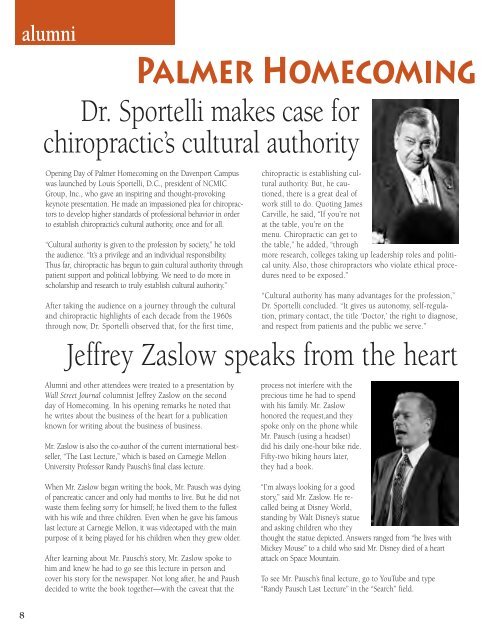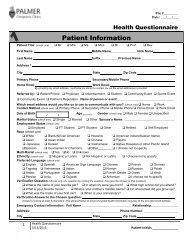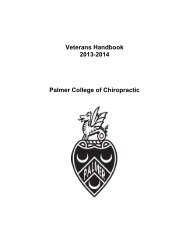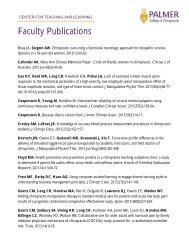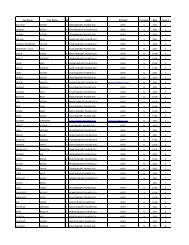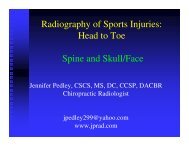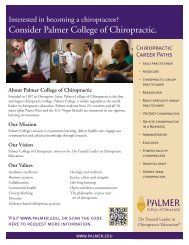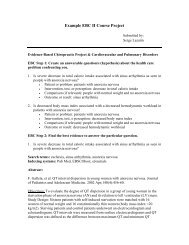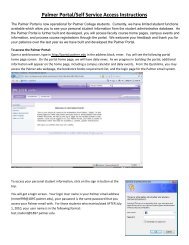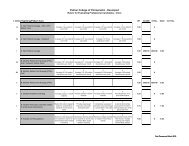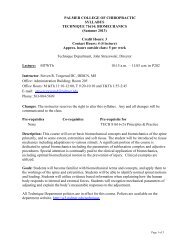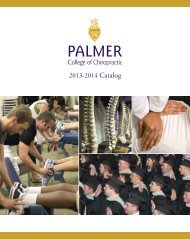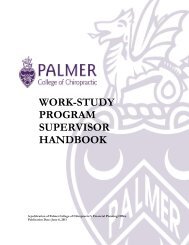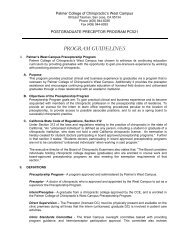ma1-091031-insightfal-bmf:Layout 1 - Palmer College of Chiropractic
ma1-091031-insightfal-bmf:Layout 1 - Palmer College of Chiropractic
ma1-091031-insightfal-bmf:Layout 1 - Palmer College of Chiropractic
You also want an ePaper? Increase the reach of your titles
YUMPU automatically turns print PDFs into web optimized ePapers that Google loves.
8<br />
alumni<br />
<strong>Palmer</strong> Homecoming<br />
Dr. Sportelli makes case for<br />
chiropractic’s cultural authority<br />
Opening Day <strong>of</strong> <strong>Palmer</strong> Homecoming on the Davenport Campus<br />
was launched by Louis Sportelli, D.C., president <strong>of</strong> NCMIC<br />
Group, Inc., who gave an inspiring and thought-provoking<br />
keynote presentation. He made an impassioned plea for chiropractors<br />
to develop higher standards <strong>of</strong> pr<strong>of</strong>essional behavior in order<br />
to establish chiropractic’s cultural authority, once and for all.<br />
“Cultural authority is given to the pr<strong>of</strong>ession by society,” he told<br />
the audience. “It’s a privilege and an individual responsibility.<br />
Thus far, chiropractic has begun to gain cultural authority through<br />
patient support and political lobbying. We need to do more in<br />
scholarship and research to truly establish cultural authority.”<br />
After taking the audience on a journey through the cultural<br />
and chiropractic highlights <strong>of</strong> each decade from the 1960s<br />
through now, Dr. Sportelli observed that, for the first time,<br />
chiropractic is establishing cultural<br />
authority. But, he cautioned,<br />
there is a great deal <strong>of</strong><br />
work still to do. Quoting James<br />
Carville, he said, “If you’re not<br />
at the table, you’re on the<br />
menu. <strong>Chiropractic</strong> can get to<br />
the table,” he added, “through<br />
more research, colleges taking up leadership roles and political<br />
unity. Also, those chiropractors who violate ethical procedures<br />
need to be exposed.”<br />
“Cultural authority has many advantages for the pr<strong>of</strong>ession,”<br />
Dr. Sportelli concluded. “It gives us autonomy, self-regulation,<br />
primary contact, the title ‘Doctor,’ the right to diagnose,<br />
and respect from patients and the public we serve.”<br />
Jeffrey Zaslow speaks from the heart<br />
Alumni and other attendees were treated to a presentation by<br />
Wall Street Journal columnist Jeffrey Zaslow on the second<br />
day <strong>of</strong> Homecoming. In his opening remarks he noted that<br />
he writes about the business <strong>of</strong> the heart for a publication<br />
known for writing about the business <strong>of</strong> business.<br />
Mr. Zaslow is also the co-author <strong>of</strong> the current international bestseller,<br />
“The Last Lecture,” which is based on Carnegie Mellon<br />
University Pr<strong>of</strong>essor Randy Pausch’s final class lecture.<br />
When Mr. Zaslow began writing the book, Mr. Pausch was dying<br />
<strong>of</strong> pancreatic cancer and only had months to live. But he did not<br />
waste them feeling sorry for himself; he lived them to the fullest<br />
with his wife and three children. Even when he gave his famous<br />
last lecture at Carnegie Mellon, it was videotaped with the main<br />
purpose <strong>of</strong> it being played for his children when they grew older.<br />
After learning about Mr. Pausch’s story, Mr. Zaslow spoke to<br />
him and knew he had to go see this lecture in person and<br />
cover his story for the newspaper. Not long after, he and Paush<br />
decided to write the book together—with the caveat that the<br />
process not interfere with the<br />
precious time he had to spend<br />
with his family. Mr. Zaslow<br />
honored the request,and they<br />
spoke only on the phone while<br />
Mr. Pausch (using a headset)<br />
did his daily one-hour bike ride.<br />
Fifty-two biking hours later,<br />
they had a book.<br />
“I’m always looking for a good<br />
story,” said Mr. Zaslow. He recalled<br />
being at Disney World,<br />
standing by Walt Disney’s statue<br />
and asking children who they<br />
thought the statue depicted. Answers ranged from “he lives with<br />
Mickey Mouse” to a child who said Mr. Disney died <strong>of</strong> a heart<br />
attack on Space Mountain.<br />
To see Mr. Pausch’s final lecture, go to YouTube and type<br />
“Randy Pausch Last Lecture” in the “Search” field.


